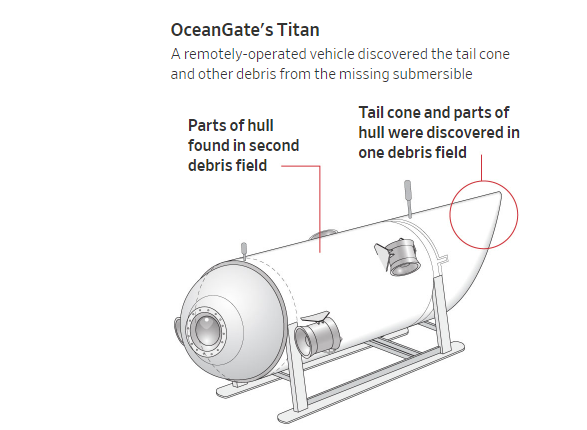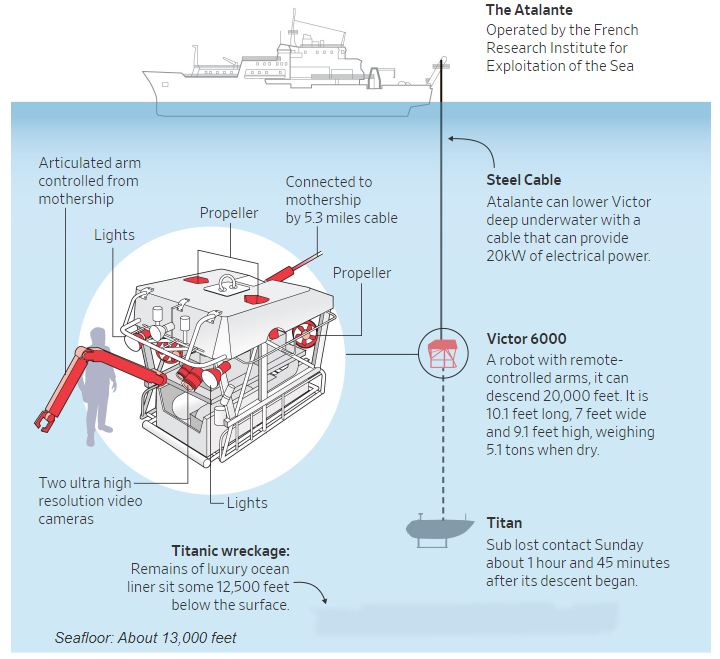
This article is more than
2 year oldThe five men onboard the missing submersible in the North Atlantic are believed to be dead, the U.S. Coast Guard and the company that operated the vessel said, after searchers found debris from the craft that ended a desperate search to find them alive.
OceanGate Expeditions, the company that operated the vessel, said in a statement Thursday that the five passengers “have sadly been lost.”
“We grieve the loss of life,” the company said.
The men who were aboard the craft were: Stockton Rush, the founder and chief executive OceanGate; Paul-Henry Nargeolet, considered a leading authority on the Titanic; Shahzada and Suleman Dawood, members of one of Pakistan’s richest families; and Hamish Harding, a British aviator and explorer.

The submersible had left Sunday for what was supposed to be an hourslong excursion to the Titanic shipwreck more than 2 miles underwater, but it lost contact with the outside world. The disappearance set off an urgent international search effort to find them alive. The Coast Guard said earlier Thursday that crews had identified debris near the Titanic shipwreck.
“The debris is consistent with the catastrophic loss of the pressure chamber,” Coast Guard Rear Adm. John Mauger, who has been leading the search, said Thursday afternoon.

Several aircraft and remotely-operated vehicles had been searching for the submersible in an area where underwater noises had been detected several times earlier this week, the Coast Guard has said. The state of the submersible had been an open question. If it had been intact, officials had estimated oxygen would have run out by Thursday morning.
Rescue teams and equipment, including a specialized U.S. Navy salvage system that can lift heavy loads from the ocean floor, raced to the site since the submersible went missing Sunday. The underwater craft, known as the Titan and operated by OceanGate Expeditions, was expected to bring five men on an hourslong excursion to the Titanic shipwreck more than 2 miles underwater, but it lost contact with the outside world.
Searchers must examine the debris more closely using a videocamera to determine whether it is from the Titan submersible, according to Larry Mayer, director of the Center for Coastal and Ocean Mapping at the University of New Hampshire.
“We need to eventually get close enough and see things with cameras to really verify what they are,” Mayer said. “The problem of course, is that the Titanic area itself is a huge debris field.”
Even before the debris field was discovered, hope of finding the passengers alive was fading Thursday for two reasons: the difficulty of finding the small submersible in a vast ocean and steep challenges regarding how to retrieve the submersible if it were found underwater.
Oxygen supply was one of many data points that rescue crews were considering, also including limited rations on board the vessel.
“We continue to find in particularly complex cases that people’s will to live really needs to be accounted for as well,” Mauger, who is leading the search, told NBC’s “Today” on Thursday morning.
Mauger later told Sky News that a thorough investigation into the events surrounding the submersible’s disappearance would be undertaken in due course but that the focus now was on search and rescue.
The Coast Guard said Thursday that no estimates had been made about when it could shift to a recovery phase, a stage that would mean they had given up hope of finding the crew alive.
“We’re going to continue searching throughout the day for this,” Mauger said.

A variety of specialized deep-sea vessels had arrived in the search area about 900 miles off Cape Cod, and more were on the way. The Canadian vessel Horizon Arctic deployed a remotely-operated vehicle, or ROV, that has reached the sea floor and begun its search for the missing submersible, the Coast Guard said Thursday.
A team of French experts arrived at the search site and sent out a so-called Victor 6000 autonomous robot capable of descending to a depth of 20,000 feet, far deeper than the wreckage of the Titanic, according to the French Research Institute for Exploitation of the Sea.
The Atalante, the French ship on which the robot arrived, used a multibeam sonar to produce a more granular cartography of the site to make the robot’s dive more efficient, a spokeswoman for the institute said.
A deep-sea ROV from British company Magellan is also on its way to the search area, the Coast Guard said. And a submersible that has previously explored the Titanic wreck is being flown in from the U.K.
“While there is a lot of noise in the ocean, there has been banging sounds several times and that’s where the ROVs are being deployed,” a Canadian Coast Guard officer participating in the search from a rescue vessel in the area said.

In what could be a last-ditch effort, the Navy is dispatching subject experts and the portable salvage system known as a Flyaway Deep Ocean Salvage System, or FADOSS, the U.S. Coast Guard announced on Wednesday.
The FADOSS system is designed to lift “up to 60,000 pounds, for the recovery of large, bulky, and heavy sunken objects such as aircraft or small vessels,” according to the description of the system by the Navy. The official said the portable system, which has retrieved aircraft and helicopters from the ocean floor in the past, has been used to lift objects as deep as 19,000 feet in the ocean.
Titan weighs 23,000 pounds, according to OceanGate, and the Titanic shipwreck lies around 13,000 feet below the surface of the North Atlantic. It can take days to retrieve an ROV that would be able to lift the Titan to the surface, naval and marine-robotics experts said.

Henry Hargrove, a senior technical analyst at Rand Corporation, who served on U.S. submarines for 11 years, said the crew of the Titan were skilled professionals and would have made every effort to conserve oxygen by staying calm and trying to sleep.
“If you are trapped below water the standard procedure is to bang like hell for three minutes every half-hour,” he said.
International crews have combed an area at least twice the size of Connecticut for the roughly 22-foot-long submersible.
The saga has put a spotlight on a niche and generally unregulated part of the tourism industry, typically for wealthy people.
It is possible the Titan crew died from a fire, flood or other disaster, naval and marine-robotics experts said.
Guillermo Sohnlein, who co-founded OceanGate with Rush, said in a statement on Facebook that Thursday would be a critical day for the search as the vessel’s life-support supplies run low. He said he is only involved with the company now as a minority equity owner.
“I’m certain that Stockton and the rest of the crew realized days ago that the best thing they can do to ensure their rescue is to extend the limits of those supplies by relaxing as much as possible,” Sohnlein said.
Eric Niiler, Nick Kostov and Talal Ansari contributed to this article.
Write to Joanna Sugden at joanna.sugden@wsj.com, Alyssa Lukpat at alyssa.lukpat@wsj.com and Costas Paris at costas.paris@wsj.com
Corrections & Amplifications
The ship pictured helping in the search for the Titan submersible is a pipe-lay vessel. The caption in an earlier version of this article referred to it incorrectly as a research vessel. (Corrected on June 22)